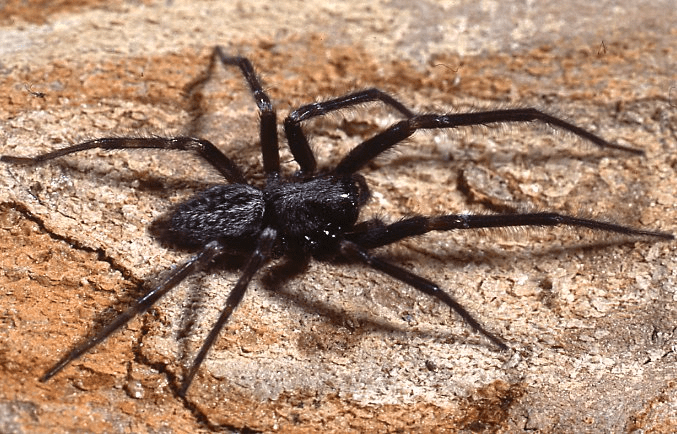The black house spider or common black spider scientifically known as Badumna insignis is a member of the spider family Desidae, native to Australia. It boasts a distinctive appearance characterized by its glossy black coloration and robust body structure. Adult females typically measure around 1.5 to 18 millimeters in length, while males tend to be smaller, ranging from 3 to 10 millimeters.
One of the striking features of the black house spider is its dark, spherical abdomen, which contrasts sharply with its lighter-colored legs. Their bodies are adorned with fine hairs, adding to their unique texture and appearance.
Habitat and Distribution
Badumna insignis is predominantly found in urban and suburban environments across Australia, including homes, sheds, garages, and other man-made structures. They construct irregular, tangled webs in secluded areas, such as corners, crevices, and ceiling spaces.
These spiders thrive in temperate climates and are well adapted to human habitats, where they prey on insects that enter buildings. While primarily indigenous to Australia, they have also been introduced to other regions around the world, including New Zealand.
Reproduction and Life Cycle of the Common Black House Spider

The life cycle of Badumna insignis begins with courtship rituals initiated by males to attract potential mates. Male spiders engage in elaborate displays, often involving vibrations and pheromones, to signal their readiness to mate. Once courtship is successful, mating occurs, after which females lay egg sacs containing hundreds of eggs.
These egg sacs are carefully guarded by the female, who affixes them to her web or shelters them in secluded areas to protect them from predators and environmental hazards. The duration of egg incubation varies depending on environmental conditions, such as temperature and humidity.
Upon hatching, spiderlings emerge from the egg sac, undergoing several molts as they transition into juvenile and eventually adult stages. The growth and development of Badumna insignis are influenced by factors like prey availability and environmental conditions.
Venom and Bite
Badumna insignis possesses venom designed primarily to subdue its prey rather than harm humans. While the venom can cause discomfort and localized reactions in humans, it is not considered highly toxic or life-threatening. The bite of a black house spider may result in symptoms such as pain, swelling, and redness at the site of the bite.
It’s important to note that black house spiders are not aggressive towards humans and typically only bite in self-defense when provoked or accidentally disturbed. Most bites occur when individuals accidentally come into contact with spiders in their natural habitats, such as within sheds, garages, or under outdoor furniture.
In the event of a spider bite, it is advisable to clean the affected area with mild soap and water, apply a cold compress to reduce swelling, and seek medical attention if symptoms persist or worsen.
Read Also: Health and Lifespan of Spiders
Predators and Prey of the Common Black House Spider

As predators, black house spiders play a vital role in controlling insect populations within their habitats. They prey on a variety of insects, including flies, mosquitoes, moths, and beetles, contributing to the natural balance of ecosystems and reducing the abundance of pest species.
While Badumna insignis primarily feeds on insects trapped in its web, it is also vulnerable to predation by various other species. Predators of black house spiders include birds, lizards, other spiders, and sometimes small mammals. These predators play a crucial role in regulating spider populations and maintaining ecological balance.
Conversely, black house spiders may fall victim to parasitism by certain wasp species that lay their eggs on or near spider egg sacs. The emerging wasp larvae then consume the spider eggs as a food source, illustrating the complex web of interactions within ecosystems.
Behavior and Web-building
Black house spiders are renowned for their adept web-building skills. They construct asymmetrical, messy webs, which serve as both hunting grounds and shelters. Unlike orb-weavers that create intricate, circular webs, the webs of Badumna insignis are irregular and loosely woven, often resembling a disorganized tangle of silk threads.
These spiders typically remain hidden within their webs, waiting patiently for unsuspecting prey to become ensnared. Once trapped, they swiftly immobilize their victims with venom injected through their fangs, before proceeding to feed on them at their leisure.
Ecological Role and Significance

Despite their fearsome appearance, black house spiders play a crucial ecological role by helping to control insect populations. By preying on flies, mosquitoes, moths, and other pests, they contribute to the natural balance of ecosystems and reduce the need for chemical insecticides in residential areas.
Moreover, Badumna insignis serves as a vital food source for various predators, including birds, lizards, and other spiders. Their presence within urban environments underscores the interconnectedness of diverse species and the importance of maintaining biodiversity.
In conclusion, the common black house spider, Badumna insignis, is a captivating arachnid species that has adapted remarkably well to human habitats. From its sleek black appearance to its intricate web-building techniques and ecological significance, this spider offers a wealth of insights into the wonders of the natural world.
The common black house spider, Badumna insignis, exemplifies the intricacies of reproduction, venom dynamics, and predator-prey relationships within its habitat. By studying these aspects, we gain a deeper appreciation for the role of spiders in ecosystems and the delicate balance of nature.
Next time you encounter a black house spider in your home or garden, take a moment to appreciate its beauty and ecological role. By fostering a deeper understanding of these remarkable creatures, we can cultivate a greater appreciation for the biodiversity that surrounds us.
Read Also: Practical Steps to Convert Wood Wastes into Particleboard





